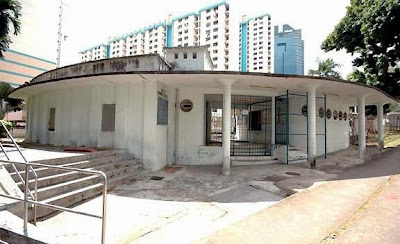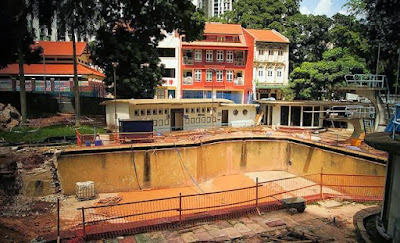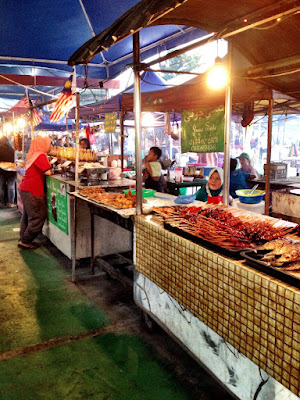Recently, I went for a walk at Yishun Neighbourhood Park, next to Masjid Darul Makmur. I saw many rubber seeds and seed pods on the ground, and I was reminded of a toy my father used to make for me in early 90's. I don't think the younger readers know about the naughty thing I can do with rubber seed pods; rubbing it on the cement floor until it becomes hot and then pressing it against my victim's arm without warning. Besides rubbing hot rubber seed pod on unsuspected victims, I made a propeller turned continuously by attaching it to a rubber seed.
 |
| Rubber seed pod |
How to do it?
Use the two sharp pointed ends at the top of the seed pods. By assembling two pieces one in the opposite direction, you can form a coupling. You then gently hold/clamp it with your thumb and middle-finger on the two pointed ends, and form a sort of wind-vane. When you blow on the seed pod, the coupling will rotate.
Materials used:-
A rubber seed, an ice cream stick, a short satay stick and a piece of string.
Methods:-
[1] Make 3 holes on the rubber seed (top, bottom and center).
[2] Empty the contents (kernel) inside the seed.
[3] Fashion a propeller from ice cream stick and stick it to one end of the satay stick. Put the other end through the top hole on the rubber seed until it appears at the bottom.
[4] Tie the piece of string to the center of the satay stick. Take out the free end of the string from the center hole. Pull tight and then roll the string around the satay stick many times by turning the propeller.
[5] Now pull the string and the propeller will turn in one direction. The trick is to pull the string half way and let go for it to rewind around the stick. When pull again, the propeller will turn in the opposite direction.
Sand-Based Playgrounds:-
When I was a little kid, I spent hours of my childhood playing in these sand-based playgrounds. The memories of these playgrounds are precious to a whole generation of Singaporeans born between the 70's and 80's.
Today, most of them were demolished, with only a few of them forgotten in the corners of the old estates.
It is a matter of time before they vanish and be replaced by the new plastic playgrounds with rubber mats.
These sand-based playgrounds are made up with ladders, slides and a long metal body, accompanied by a set of rubber tyre as swings and a merry-go-round. Some of these playgrounds are also mainly made up horizontal and diagonal metal bars, completed with two slides, swings and wooden planks see-saws.
One of the favorite games that kids used to play in this playground was perhaps 'catching', or 'police and thieves', where the game was made difficult by having a rule that no one could come in contact with the sand, or he would be penalized.
I can still remember thin kids were bullied by some plump heavy kids who would sit on one end of see-saw, leaving thin kids suspended in the air at the other end.
Many of us will also not forget the giddy sensation on a merry-go-round, where the naughty ones would frighten the others by pushing the merry-go-round at very high speed.
 |
| Image: sbstransit |
 |
| Image: sbstransit |
SBS Bus:-
When it first kicked off at Tampines in early 80's, Singaporeans were not willing to take the double-deck buses as they afraid the buses would topple.
 |
| Image: publictransportsg |
 |
| Image: publictransportsg |
City Shuttle Bus:-
Started in 1975, City Shuttle Service (CSS) used to operate within the Central Business District (CBD). Receiving poor responses from the public, the service began to switch to regular trips from the new towns to CBD. By 1990, due to low ridership, the bus fleet was downsized and the service was finally terminated in 2007.
Who can forget the signature yellow-orange single-deck buses of Trans-Island Bus Services (TIBS) roaming in the northern towns of Singapore, from Woodlands to Sembawang to Yishun?
The company was founded in 1982 so as to provide competition to the Singapore Bus Services (SBS). It was taken over by SMRT Corporation in 2001.
TransitLink Fare Card:-
Every bus came equipped with a Fare Card machine and we had to insert our card at the top, press the fare we are paying, then the machine would make lots of weird noises before our card came out with a ticket from the bottom.
 |
Image: National Archives Of Singapore
|
Ma Pi Po Boy and Karung Guni Man:-
A heart-lander living in a HDB flat during the 90's would know two identification code words from two professions.
One was the newspaper delivery boy, who announced his arrival, armed with Mandarin newspaper Wanbao and Shin Min, by shouting "Ma Pi Po" loud and clear.
The other was the Karung Guni Man, pressing his horn with a signature chant - "Karung guni, buay bor zua, gu sa kor, ley lio, dian si kee.." (translated as "Rag and bone, buy newspapers and old clothes, radios and televisions.")
The Karung Guni Man is still making his rounds nowadays though.
"Lai.. lai.. Masuk dalam! Masuk dalam!" is Malay for "Come.. come.. Move inside! Move inside!"
This is a common expression that kids of my generation used to hear on the buses. They were uttered by the fierce Bus Conductors who wanted us to move to the rear of the bus and not crowd around the entrance.
I would like to share with you more about the bus taking experience of the 'old days'. It's about my experience taking Bas Pekerja or Bas Kilang from Johor Custom to Singapore Custom in 1998 to mid 1999.
For one and the half year, I had to travel from my home in Taman Puteri Wangsa (Johor) to Marsiling Primary School by boarding Bas Pekerja.
As you might expect, hundreds of workers and students taking public transport from Johor Custom to Singapore Custom early in the morning. You can imagine the mad rush and the packed condition in those peak hours.
As expected, buses were often very crowded. Sometimes the bus was so packed that you didn't need to hold the overhead railings to maintain your balance.
The situation was not helped by the fact that many 'kiasu' passengers were reluctant to move to the front and rear sections for fear that they would not be able to make it to the single entrance/exit which was usually at the center of the bus. Consequently, we often had to cling on the side rail at the entrance of the bus with one foot on the steps and our bodies hanging out of the bus.
Sometimes, a Bus Conductor from the Singapore Bus Services (SBS) will board Bas Pekerja, used his metal ticket punch to knock our fingers in an attempt to dislodge us.
One thing I liked about this dangerous practice was that I was able to enjoy a bit of natural air-con plus we needn't pay the bus fare.
Another dangerous thing I liked to do was to imitate the Ticket Inspectors by jumping off the bus before it came to a complete halt. I would hit the ground running.
Provision Shops:
Once a common sight in Singapore, having reached its peak in the mid 70's with more than 2000 of them scattered all around the country. As development gathered pace, and shopping of groceries made easier with the opening of modern supermarkets, mini-marts and convenient stores, many traditional provision shops are facing an uncertain future.
Today, less than 150 provision shops are still in business. Many have been struggling with the stiffer competition and lack of successors.
Little vintage gems can be found inside the provision shops, as though they have been frozen in time. Old black power switches and sockets are attached to the wooden beams, same as those that were once commonly found in households many decades ago. A wooden weight, in the shape of a beer bottle, was once used to balance a Milo tin can that functioned as a 'cashier box'.
Unlike supermarkets or convenient stores, provision shop owners built up good relationships with their customers, often by giving credits, a practice that some traditional provision shops still observe today, or home delivery services.
Many decades have since gone by. Some had changed their business model. Others had opened and shut down. Those that have remained today are likely to struggle. Will the traditional provision shops officially walk into history one day? Or will they be able to stand the test of time? Perhaps next time when you walk past a traditional provision shop, show your support by buying some canned drinks or chocolate bars from them.
Pasar Malam:
Of course we kids loved going to Pasar Malam. They were noisy and colourful. Mostly, we liked the snacks and drinks. We would have Ice-Cream Potong, Kacang Putih and many more. There were also Malay traditional foods.
Pasar Malam in the 90's were street affairs with goods and merchandise displayed on canvas sheets on the ground. For light, the vendors would use a pump kerosene lamp. This lamp could get glaringly bright, its mesh bulb mesmerizing. It reminded me of the sun and I often imagine it exploding into a million pieces like in some sci-fi movie. For that reason, I would never stand too close to one..!
























































